Home > Digitized Walters Manuscripts
This document is a tranformation of a TEI P5 XML manuscript description incorporating images. If you have trouble reading special or non-Latin characters on this page, please make sure you have appropriate Unicode fonts installed and an up-to-date web browser.
Walters Ms. W.521, "Imperial" Menologion
Browse images (Browse images in a new window) | TEI in XML format
W.521
"Imperial" Menologion
This manuscript contains the biographies of saints whom the church commemorates in the month of January. It was originally part of a set that covered the whole year. A companion volume, with texts for March, now survives in Moscow (State Historical Museum MS Synod. gr. 183). Each chapter in both manuscripts opens with a miniature depicting the death of the respective saint, or less often, another significant event from his or her life. Each text also ends with a seven-line prayer for the well-being of an unnamed emperor. The seven lines' initial letters invariably spell "MIC[H]AEL P.", most probably indicating that all the prayers were composed by "Michael the P(atriarch)". This must be Michael Cerularius, Patriarch of Constantinople from 1043 to 1059. He must have commissioned the volumes for the purpose of being read out in the emperor's presence, probably in one of the numerous chapels of the great imperial palace. A single leaf from the Walters' volume is now kept in Berlin (Staatsbibliothek zu Berlin MS graec. fol. 31). By the sixteenth century, a number of further folios were missing and paper leaves with text copied from a Metaphrastian Menologion were added to replace them.
Second quarter of the 11th century CE
Constantinople (Istanbul)
Book
Theological
The primary language in this manuscript is Greek, Ancient (to 1453).
Parchment
Very high quality with few defects; fols. 1-11, 22, 34, 178-191, and 255-295 are paper; watermarks and countermarks similar to no. 1002 in: Mareș, Alexandru. Filigranele hîrtiei întrebuinţate în ţările române în secolul al XVI-lea. Bucharest: Editura Academiei Republicii Socialiste România, 1987.
Foliation: i+295+i
Pencil foliation in upper right corners of rectos
Formula: 1(12,-1), 2(8,-1), 3-9(8), 10(10,-2,8), 11-21(8), 22(8,-8), 23(2,-1), 24(8), 25(6,-3), 26-32(8), 33(8,-8), 34 (2,-1), 35-38(10)
Catchwords: Last leaf of each paper quire, middle of lower margin
Signatures: Armenian and Greek numerals by three different hands (none of which is that of the original scribe) in middle of lower margin of each quire's first and last pages
Comments: Quires begin on fols. 1(1), 12(2), 19(3), 27(4), 35(5), 43(6), 51(7), 59(8), 67(9), 75(10), 83(11), 91(12), 99(13), 107(14), 115(15), 123(16), 131(17), 139(18), 147(19), 155(20), 163(21), 171(22), 178(23), 179(24), 187(25), 192(26), 200(27), 308(28), 216(29), 224(30), 232(31), 240(32), 248(33), 255(34), 256(35), 266(36), 276(37), 286(38). Quires 1, 23-25, and 35-38 are paper. Quire 3, leaf 4 is a paper replacement, quire 4, leaf 8 is a paper replacement. The manuscript has been misbound: quire 10 was originally placed after the current quire 22.
23.0 cm wide by 30.0 cm high
fols. 1r - 295v: 14.0 cm wide by 20.5 cm high
fols. 1r - 11r; 22r - 22v; 34r - 34v; 178r - 191v; 255r - 295v: 15.5 cm wide by 22.5 cm high
- Columns: 2
- Ruled lines: 26
- Columns: 1
- Ruled lines: 26
- Title: Menologion for January
- Contents: Imperial Menologion with sixteenth-century additions from Metaphrastian Menologion
- Hand note: Written in regular calligraphic minuscule; one hand throughout
- Decoration note: Twenty-four half-page miniatures; occasional enlarged initials in red (2-4 lines); small red initials throughout; rubrics in red; text in brown ink
- Title: "Imperial" Menologion for January
- Contents: Fols. 12r-22r: January 2, Life of Pope Silvester (Bibliotheca Hagiographica Graeca 1632e), beginning now in Berlin, Staatsbibliothek zu Berlin MS graec. fol. 31, end supplied on paper; fols. 23r-24v: January 3, Life of the prophet Malachias (BHG 1014e), beginning lost; fols. 25r-27v: January 4, Martyrdom of SS. Theopemptus and Theonas (BHG 2444); fols. 28r-35v: January 5, Life of St. Paul of Thebes (BHG 1468c), with part supplied on paper; fols. 36r-37v: January 5, Life of the prophet Micah (BHG 1281e); fols. 38r-48r: January 6, Sermon on the Feast of the Baptism by Gregory of Nazianzus (Codex Parisinus Graecus 3010.39; BHG 1838b); fols. 48v-50r: January 7, Life of St. John the Baptist (BHG 838e); fols. 50v-56r: January 8, Life of St. Zoticus (BHG 2479); fols. 56v-60v: January 9, Martyrdom of St. Polyeuctus (BHG 1568d); fols. 61r-70r: January 10, Life of St. Marcianus (BHG 1034b); fols. 70v-74v, 83r-85v: January 11, Life of St. Theodosius the Coenobiarch (BHG 1778b); fols. 75r-82v: Fragment from the life of St. Euthymius, beginning and end missing (BHG 648e, including 648d); fols. 86r-87v: January 12, Martyrdom of St. Tatiana (BHG 1699d); fols. 88r-92r: January 13, Martyrdom of SS. Hermylus and Stratonicus (BHG 745b); fols. 92v-95v: January 14, Martyrdom of the monks of Sinai and Raithou (BHG 1307d); fols. 96r-104v: January 15, Life of St. John the Poor (BHG 869b); fols. 105r-113r: January 16, Sermon on the Veneration of the Chains of St. Peter (BHG 1486a); fols. 113v-129r: January 17, Encomium for St. Antony (BHG 141d); fols. 129v-150v: January 18, Life of St. Athanasius of Alexandria (BHG 183a); fols. 151r-155r: January 18, Life of St. Cyril of Alexandria (BHG 2096); fols. 155v-158r: January 19, Life and martyrdom of St. Theodotus of Cyrenia (BHG 2437); fols. 158v-199v: January 20, Life of St. Euthymius (BHG 649a), with parts supplied on paper; fols. 200r-203r: January 21, Martyrdom of St. Neophytus (BHG 1326b); fols. 203v-207r: January 22, Life of the Apostle Timothy (BHG 1848b); fols. 207v-227v: January 23, Martyrdom of St. Clement of Ancyra and Agathangelus (BHG 354d), lacking text after fol. 207; fols. 228r-234r: January 24, Life of St. Xenia (BHG 634a); fols. 234v-254v: January 25, Life of St. Gregory the Theologian (BHG 723), end supplied on paper
- Title: Metaphrastian Menologion for January
- Contents: Fols. 1r-v: Table of Contents; fols. 1v-11r: January 1, Sermon in Praise of St. Basil by Amphilochius of Iconium (CPG 3253, BHG 247-252); fol. 22: Part of the life of Pope Sylvester; fol. 34: Part of the life of St. Paul of Thebes; fols. 178-191: Parts of the life of St. Euthymius; fols. 255r-258r: End of the life of St. Gregory the Theologian (BHG 723); fols. 258r-267r: January 26, Life of St. Xenophon, his wife, and children (BHG 1878); fols. 267v-272r: January 27, History of the return of the relics of St. John Chrysostom (BHG 877); fols. 272r-277r: January 28, Life of St. Ephraem the Syrian (BHG 584); fols. 277r-285r: January 30, Sermon in Praise of the Three Hierarchs by John of Euchaita (BHG 747); fol. 285v–291v: January 31, Life and martyrdom of SS. Cyrus and John (BHG 471); fols. 291v-294v: February 12: Sermon in Praise in St. Meletius of Antioch by St. John Chrysostom (CPG 4345, BHG 1244)
- Hand note: Written in small sloping minuscule; one hand throughout
fol. 25r:
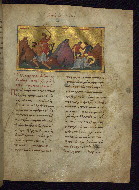
- Title: Exploit of Christ's holy and glorious martyrs Theopemptus and Theonas
- Form: Half-page miniature
- Label: Theopemptus, a victim of the persecution of Christians ordered by Emperor Diocletian ca. 303, is seen on the left, about to be beheaded. The figure lying dead on the right is Theonas, who at Diocletian's order had prepared a deadly poison for Theopemptus and was converted when he saw how little effect the drink had on the saint. Theonas has been buried alive by the two youths who stand behind with shovels.
fol. 28r:
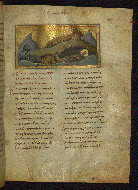
- Title: Life and conduct of Our Holy Father Paul of Thebes
- Form: Half-page miniature
- Label: St. Paul lived as a recluse in the Thebaid desert of Egypt and died there ca. 341. St. Antony the Great, another Egyptian ascetic, had met Paul once and conversed with him. When he came to visit Paul for a second time, Antony found that he had already expired. Here, the dead monk lies in his cave, eyes shut and hands crossed on his chest; Antony bends over his feet.
fol. 36r:
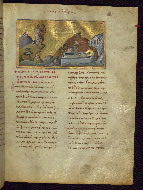
- Title: Commemoration of the holy and glorious prophet Micah
- Form: Half-page miniature
- Label: At the left, Micah is about to be pushed over a cliff at the order of King Jotham of Judah (ruled probably 740-736 BCE). At the right, two men have laid the prophet's dead body into a stone coffin. The elder one is raising his veiled hands to his chin as a sign of mourning.
fol. 38r:
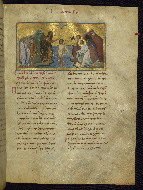
- Title: Oration on the Feast of the Baptism by Our Holy Father Gregory the Theologian
- Form: Half-page miniature
- Label: Baptism of Christ
fol. 48v:
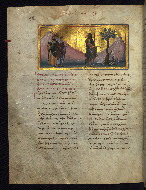
- Title: Commemoration of Christ's holy and glorious prophet, Forerunner and Baptist John
- Form: Half-page miniature
- Label: St. John the Baptist is shown preaching to a group of three men and pointing to a tree with an axe laid at its roots (Matthew 3:10; Luke 3:9).
fol. 50v:
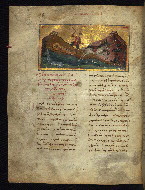
- Title: Life, conduct, and martyrdom of Our Holy Father Zoticus the Nourisher of the Poor
- Form: Half-page miniature
- Label: Zoticus, bishop of Comana in Asia Minor, suffered martyrdom in 204 during the persecution mounted by Emperor Septimius Severus. The miniature shows his execution: he was bound to a pair of mules, which dragged his body over the ground to death.
fol. 56v:
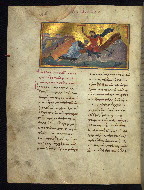
- Title: Exploit of Christ's holy and glorious martyr Polyeuctus
- Form: Half-page miniature
- Label: The saint being beheaded here is Polyeuctus, a Roman army officer martyred at Melitene in Asia Minor under Emperor Valerian in 259. The rich tunic that he wears was, according to the accompanying text, given to him by Christ, whom he saw in a vision.
fol. 61r:
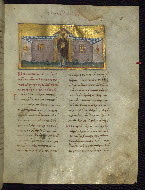
- Title: Life and conduct of Our Holy Father Marcian, priest and steward of the Great Church [of St. Sophia in Constantinople]
- Form: Half-page miniature
- Label: St. Marcian died ca. 473 and is known primarily for the many churches he founded in Constantinople. The miniature portrays him clad in priestly vestments, holding a golden Gospel Book and standing in front of a decorated entranceway.
fol. 70v:
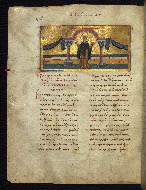
- Title: Life and conduct of Our Holy Father Theodosius the Coenobiarch
- Form: Half-page miniature
- Label: St. Theodosius (died 529) was organiser of the coenobitic (communal) way of monastic life and founded several monasteries in Palestine, one of which still exists near Bethlehem. The saint, wearing a monastic habit, stands here in front of a piece of decorative background architecture.
fol. 86r:
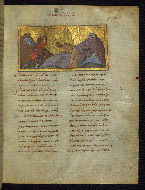
- Title: Exploit of the holy and glorious virgin martyr Tatiana
- Form: Half-page miniature
- Label: Tatiana, a deaconess, was martyred in Rome during the reign of the emperor Alexander Severus, ca. 225-230. To dishonor the maiden, her pagan torturers had her head shaved before beheading her.
fol. 88r:
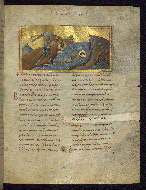
- Title: Exploit of Christ's holy and glorious martyrs Hermilus and Stratonicus
- Form: Half-page miniature
- Label: Hermilus and Stratonicus were martyred near Singidunum (modern Belgrade) during the persecution ordered by the emperor Lycinius in 315. In the miniature, one of them is just about to be thrown into the river Danube, hands bound behind his back and a stone tied to his neck. The body of the other saint is already sinking into the water.
fol. 92v:
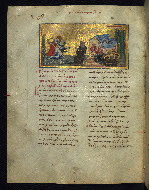
- Title: Life, conduct, and exploits of Our Holy Fathers killed at Sinai and Raithou
- Form: Half-page miniature
- Label: The miniature shows a group of monks from Raithou, on the Sinai Peninsula, slaughtered by pagan nomads from the Blemmyes tribe ca. 450.
fol. 96r:
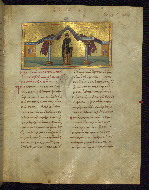
- Title: Life and conduct of Our Holy Father John, who lived in poverty for Christ's sake
- Form: Half-page miniature
- Label: St. John Calybites (the "Hut-Dweller"), known for his ascetic life of extreme poverty, lived in Constantinople ca. 450. Before taking monastic vows, he asked his parents to buy him a decorated Gospel Book, which he is seen holding in this miniature.
fol. 105r:
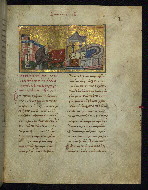
- Title: Oration on the Veneration of the Chains of St. Peter
- Form: Half-page miniature
- Label: The chains that had bound the hands of St. Peter when he was imprisoned by Herod (Acts 12:6) were brought from Jerusalem to Constantinople in 438 by Eudocia, pious wife of the emperor Theodosius II. In this miniature, an anonymous bishop bows before them in an act of veneration. The relic has not actually been represented by the painter, but it supposedly lies on a table covered with red cloth and placed in front of a church altar. The altar itself is surmounted by a marble canopy and separated from the nave by a low parapet (chancel). The semi-circular benches (synthronon) behind it are seats for the high clergy. These details reflect the arrangement existing in Byzantine churches ca. 1040, when the miniature was painted.
fol. 113v:
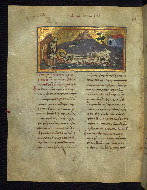
- Title: Encomium for Our Holy Father the Miracle-Worker Antony
- Form: Half-page miniature
- Label: St. Antony (died 359) is an Egyptian hermit generally considered the founder of Christian monasticism. His death is shown here in a scene very similar to that of his friend St. Paul of Thebes (fol. 28r). Two monks are taking leave of the deceased master.
fol. 129v:
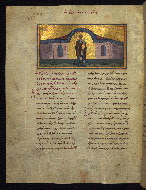
- Title: Life and conduct of Our Holy Father the Confessor Athanasius, bishop of Alexandria
- Form: Half-page miniature
- Label: St. Athanasius, patriarch of Alexandria from 328 to 373, is famous for his struggles against heresy. He is shown here dressed in episcopal vestments and holding a Gospel Book (compare the images of other sainted bishops on fols. 151r and 155v).
fol. 151r:
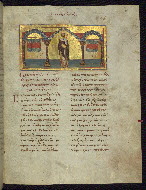
- Title: Life and conduct of Our Holy Father Cyril, bishop of Alexandria
- Form: Half-page miniature
- Label: St. Cyril was patriarch of Alexandria from 412 to 444, and is commemorated by the church on the same day as his predecessor St. Athanasius (fol. 129v). Like him, Cyril was an active opponent of heresy and paganism.
fol. 155v:
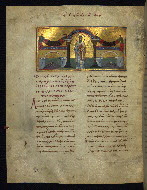
- Title: Life, conduct and martyrdom of the holy martyr Theodotus, bishop of the city of Cyrenia in Cyprus
- Form: Half-page miniature
- Label: Theodotus, a bishop on the island of Cyprus, was martyred under the emperor Licinius in 326. Rather than depicting his execution (compare to fol. 207v), this miniature simply portrays him standing before a set of conventional buildings, dressed in episcopal costume.
fol. 158v:
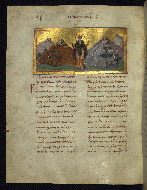
- Title: Life and conduct of Our Holy Father Euthymius
- Form: Half-page miniature
- Label: St. Euthymius (377-473) founded monastic communities throughout Palestine. Parts of the miniature here have been covered with transparent glue to preserve it from flaking.
fol. 200r:
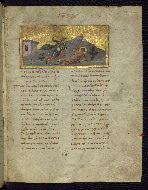
- Title: Exploit of the holy and glorious martyr Neophytus
- Form: Half-page miniature
- Label: The young Christian Neophytus, a native of Nicea in Asia Minor, was martyred under Emperor Diocletian in 304. This miniature shows him falling to the ground under the blows of a henchman's club.
fol. 203v:
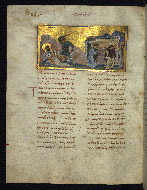
- Title: Commemoration of Christ's holy and glorious Apostle Timothy
- Form: Half-page miniature
- Label: Two separate episodes are depicted within a single frame. On the left, Christ's disciple Timothy is being clubbed to death by one of the pagans whose festival he had disrupted. He wears an episcopal stole (omophorion) because he is bishop of Ephesos. At the right, two men carry a coffin, while a priest before them swings a lit censer. This represents either the burial of Timothy at Ephesos or the translation (transfer) of his remains to the Constantinopolitan Church of the Holy Apostles in 356.
fol. 207v:
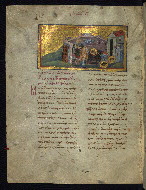
- Title: Exploit of the holy martyr Clement, bishop of Ancyra and Agathangelus
- Form: Half-page miniature
- Label: In 312, Clement, bishop of Ancyra (modern Ankara), was beheaded by a Roman soldier while celebrating the Divine Liturgy. Behind the altar lie the bodies of his deacons Christopher and Chariton.
fol. 228r:
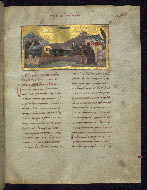
- Title: Life and conduct of St. Xenia, born Eusebia
- Form: Half-page miniature
- Label: Eusebia was born to wealthy parents in Rome, but avoided marriage and eventually died ca. 450 as a nun (under the monastic name Xenia, "Stranger") at Mylassa in Asia Minor. The scene of her demise here is similar to that of male monks (fols. 28r, 113v). The buildings in the background probably represent Xenia's convent.
fol. 234v:
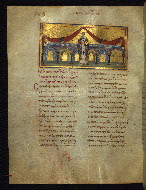
- Title: Life and conduct of Our Holy Father Gregory the Theologian, archbishop of Constantinople
- Form: Half-page miniature
- Label: Gregory of Nazianzus (died 389 or 390) is one of the most highly regarded Christian writers and theologians. Like SS. Athanasius, Cyril, and Theodotus (fols. 129v, 151r, 155v), he is portrayed here in episcopal dress, having served as archbishop of Constantinople in 379-381.
The binding is not original.
Made in 1963; red leather over squared wooden boards; flat spine; parchment flyleaves
Library of the Greek Patriarchate of Alexandria, Cairo, no. 32/33 (seen there by A. Mavrommatis in 1895 and C. R. Gregory in 1901, reported lost to C. Schmidt in 1914)
Henry Walters, Paris, acquired before 1931
Walters Art Museum, 1931, by Henry Walters' bequest
Ševčenko, Nancy Patterson. "The Walters 'Imperial' Menologion." Journal of the Walters Art Gallery 51 (1993): 43-64.
D’Aiuto, Francesco. "Nuovi elementi per la datazione del Menologio Imperiale: i copisti degli esemplari miniati." Rendiconti [dell'] Accademia Nazionale dei Lincei. Classe di scienze morali, storiche e filologiche, ser. IX, 8 (1997): 715-747.
Van den Ven, Paul. "Inventaire sommaire des manuscrits grecs de la bibliothèque patriarcale du Caire." Le Muséon, n.s. v.15 (1914): 65-82, cat. no. 33.
Zakharova, Anna Vladimirovna. "The Miniatures of the Imperial Menologion." Nea Rhome: rivista di ricerche bizantinistiche 7 (2010): 131-153
Hero, A. Constantinides, "An Anonymous Narrative of the Martyrdom of the Anchorites of Mount Sinai (BHG 307D)," in Byzantine Religious Culture: Studies in Honor of Alice-Mary Talbot, edited by D. Sullivan, E. Fisher, and S. Papaioannou. Leiden: Brill, 2012, pp. 411-420.
Ševčenko, Nancy Patterson. "El 'Menologio de Basilio II' y los 'Menologio imperiales.'" In El Menologio de Basilio II...libro de estudios con occasión de la edición facsímil, edited by Francesco D'Aiuto, 231-259. Madrid: Testimonio Compania Editorial, 2008.
Bagnoli, Martina, et al., eds. Treasures of Heaven: Saints, Relics, and Devotion in Medieval Europe. New Haven: Yale University Press, 2010, pp. 47-48, cat. no. 31.
Parpulov, Georgi. "A Catalogue of Greek Manuscripts at the Walters Art Museum." Journal of the Walters Art Museum 62 (2004): 71-189.
Halkin, François. "Le ménologe impérial de Baltimore: textes grecs publiés et traduits." Subsidia hagiographica 69. Brussels: Société des Bollandistes, 1985.
Ehrhard, Albert. "Überlieferung und Bestand der hagiographischen und homiletischen Literatur der griechischen Kirche von den Anfängen bis zum Ende des 16. Jahrhunderts." Texte und Untersuchungen zur Geschichte der altchristlichen Literatur 52. Leipzig: J.C. Hinrichs, 1939, pp. 392-397.
Principal cataloger: Parpulov, Georgi R.
Editor: Herbert, Lynley
Copy editor: Joyal, Stephanie
Conservators: Owen, Linda; Quandt, Abigail
Contributors: Bockrath, Diane; Emery, Doug; Noel, William; Tabritha, Ariel; Toth, Michael B.
The Walters Art Museum
Licensed for use under Creative Commons Attribution-NonCommercial-ShareAlike 3.0 Unported Access Rights, http://creativecommons.org/licenses/by-nc-sa/3.0/legalcode. It is requested that copies of any published articles based on the information in this data set be sent to the curator of manuscripts, The Walters Art Museum, 600 North Charles Street, Baltimore MD 21201.